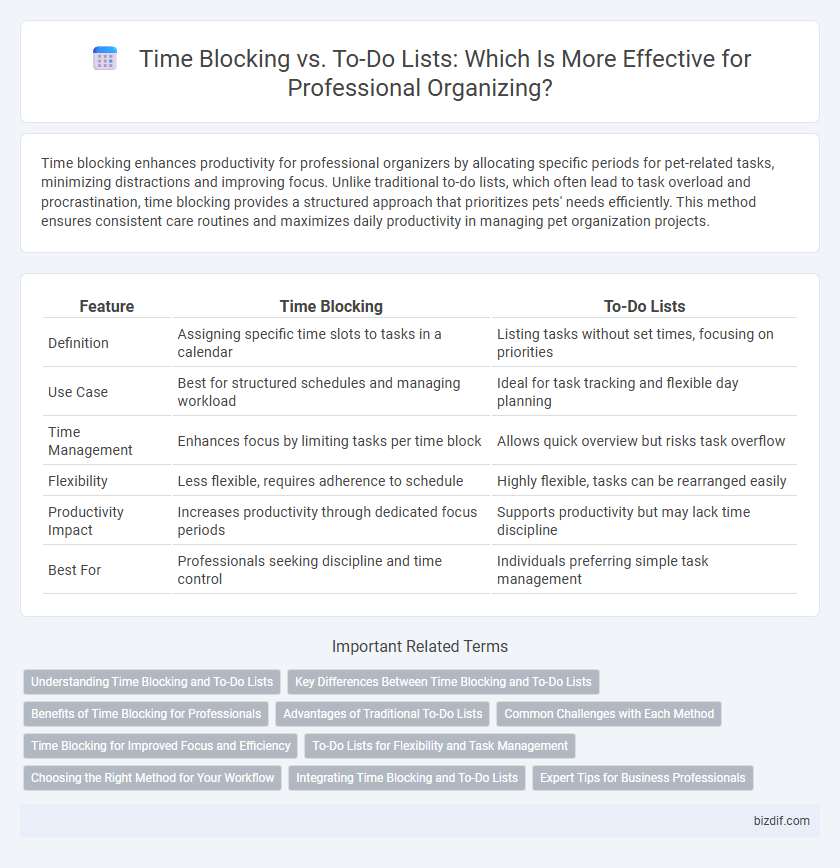Time blocking enhances productivity for professional organizers by allocating specific periods for pet-related tasks, minimizing distractions and improving focus. Unlike traditional to-do lists, which often lead to task overload and procrastination, time blocking provides a structured approach that prioritizes pets' needs efficiently. This method ensures consistent care routines and maximizes daily productivity in managing pet organization projects.
Table of Comparison
| Feature | Time Blocking | To-Do Lists |
|---|---|---|
| Definition | Assigning specific time slots to tasks in a calendar | Listing tasks without set times, focusing on priorities |
| Use Case | Best for structured schedules and managing workload | Ideal for task tracking and flexible day planning |
| Time Management | Enhances focus by limiting tasks per time block | Allows quick overview but risks task overflow |
| Flexibility | Less flexible, requires adherence to schedule | Highly flexible, tasks can be rearranged easily |
| Productivity Impact | Increases productivity through dedicated focus periods | Supports productivity but may lack time discipline |
| Best For | Professionals seeking discipline and time control | Individuals preferring simple task management |
Understanding Time Blocking and To-Do Lists
Time blocking divides your day into specific segments allocated to particular tasks, enhancing focus and reducing multitasking inefficiencies. To-do lists provide a comprehensive overview of tasks, helping prioritize and track progress but may lack structure in time allocation. Integrating both methods can optimize productivity by pairing the visual timeline of time blocking with the task management clarity of to-do lists.
Key Differences Between Time Blocking and To-Do Lists
Time blocking allocates specific time periods to tasks, enhancing focus and reducing multitasking, while to-do lists prioritize task completion but lack structured scheduling. Time blocking improves productivity by creating dedicated work intervals, whereas to-do lists offer flexibility by listing priorities without fixed timings. Understanding these distinctions helps professionals choose methods aligned with their workflow efficiency needs.
Benefits of Time Blocking for Professionals
Time blocking enhances productivity by allocating specific time slots for tasks, reducing decision fatigue and minimizing distractions. This method improves time management accuracy, enabling professionals to prioritize high-impact activities and meet deadlines consistently. By structuring the workday, time blocking fosters focused work sessions that increase efficiency and support work-life balance.
Advantages of Traditional To-Do Lists
Traditional to-do lists offer a clear and straightforward method to organize daily tasks, enhancing productivity by providing visual reminders and enabling prioritization. They facilitate task management without the need for strict scheduling, allowing flexibility to address tasks as they arise throughout the day. This simplicity supports quick adjustments and reduces the cognitive load associated with planning complex schedules like time blocking.
Common Challenges with Each Method
Time blocking often faces challenges such as rigid scheduling that can cause stress when unexpected tasks arise or meetings run over. To-do lists may lead to overwhelm and decreased productivity by accumulating excessive tasks without prioritization, causing frequent task switching. Both methods require consistent discipline and adaptability to effectively manage changing priorities and maintain focus throughout the day.
Time Blocking for Improved Focus and Efficiency
Time blocking enhances professional organizing by assigning specific time slots to tasks, reducing distractions and increasing productivity. Unlike traditional to-do lists that can become overwhelming, time blocking creates a structured schedule that promotes deep focus and efficient task completion. Studies show individuals using time blocking report higher work efficiency and better time management skills.
To-Do Lists for Flexibility and Task Management
To-do lists enhance flexibility in professional organizing by allowing dynamic prioritization and easy adjustments throughout the day. They enable efficient task management by breaking down projects into actionable steps, ensuring nothing is overlooked. This adaptability supports productivity across varying workloads and unexpected schedule changes.
Choosing the Right Method for Your Workflow
Time blocking enhances productivity by allocating specific time slots for tasks, reducing multitasking and improving focus, while to-do lists offer flexibility and a clear overview of pending activities. Selecting the right method depends on individual workflow preferences, task complexity, and the need for structure versus adaptability. Professionals often combine both strategies for optimal time management and task completion efficiency.
Integrating Time Blocking and To-Do Lists
Integrating time blocking and to-do lists enhances productivity by combining structured scheduling with task prioritization, ensuring both deadlines and important activities are addressed efficiently. Time blocking allocates specific periods for focused work, while to-do lists provide a comprehensive overview of tasks, allowing for dynamic adjustments throughout the day. Utilizing digital tools like Google Calendar alongside task management apps such as Todoist optimizes this integration, promoting better time management and goal achievement.
Expert Tips for Business Professionals
Time blocking enhances productivity by allocating specific periods for focused tasks, reducing distractions and multitasking common in business environments. Expert business professionals recommend combining time blocking with prioritized to-do lists to ensure critical deadlines are met while maintaining workflow flexibility. This integrated approach optimizes schedule management, boosts concentration, and supports efficient completion of high-impact projects.
time blocking vs to-do lists Infographic

 bizdif.com
bizdif.com